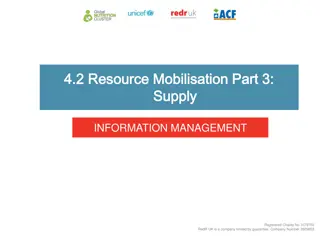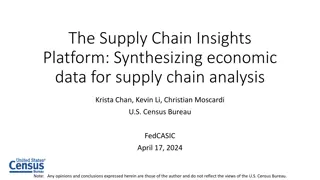Understanding Power Supply Design Considerations
Design considerations for power supplies involve DC-DC conversion, voltage regulation, efficiency trade-offs, and choosing between linear and switching regulators. Key aspects include voltage regulation reasons, imaginary perfect regulators, linear regulators (including LDOs), switching regulators, and tips for selecting regulators. Considerations such as efficiency, cost, footprint, ripple, and quality of regulation play crucial roles in power supply design.
Download Presentation

Please find below an Image/Link to download the presentation.
The content on the website is provided AS IS for your information and personal use only. It may not be sold, licensed, or shared on other websites without obtaining consent from the author. Download presentation by click this link. If you encounter any issues during the download, it is possible that the publisher has removed the file from their server.
E N D
Presentation Transcript
Power supply Design considerations
Outline DC-DC conversion and voltage regulation Buck: Regulating wall-wart/battery output to desired voltage Boost: Size constrained systems (Run off single AAA, for example) Sources Plugged-in AC-DC conversion Short answer: use third party supplies DC-DC conversion Battery-based High current draw vs. Low current draw Rechargeable vs. non-rechargeable
Voltage regulation Why? Variable voltage drop based on current draw Internal resistance, wire resistance Spurious resets on current spikes Signals are typically in supply range Rail-to-rail Ground to VCC Narrower range is common Supply noise Noisy signals
Imaginary perfect regulator Efficiency = 100% Input power = output power Vin* Iin= Vout* Iload Vout is constant; no ripple Efficiency Cost/ footprint Low ripple/ quality of regulation What do we have to give up in practice? Efficiency, High quality (low ripple), low cost/footprint Pick any two.
Linear regulators (including LDOs) Two major categories Linear regulators (including LDOs) Switching regulators (aka switchers) Linear regulators Wasteful (thermal waste of energy) Power dissipation = Vin * Iload Useful work = Vout * Iload Efficiency Cost/ footprint Low ripple/ quality of regulation Linear regulators Small voltage buck and/or low load current 5V 3.3V,
Switching regulators High efficiency 85%-96% Noisy Average voltage is well-regulated A/C noise component Efficiency Cost/ footprint Low ripple/ quality of regulation
Tips For fixed voltage with very low dropout, look for custom regulator E.g. MCP 1700 with < 180mV dropout, up to 250mA Can get 3.3V regulation on LiPo batteries (3.7V) Good old 78xx (fixed and variable regulators in family) 2V dropout Switching regulators Pre-packaged drop-in regulator (e.g., OKR-T/3-W12-C) 7805 drop-in replacement (e.g., Murata 78xxSR) Using discrete regulator ICs Delicate designs. Use passives and layout recommended in datasheet
Heat Sink Pay attention to heat thermal issues More important in Linear regulators Follow datasheet recommendations Will need understanding of current demands of your project
Boost DC/DC conversion Common case: Buck (step-down) regulation Extreme low power: Operate on 1 AA battery or button cell Boost to more reasonable supply. Typically low-current draw Maybe a sensor or low-duty cycle application Lots of boost converter ICs Attiny43U (Microcontroller with built-in boost converter) Operates down to 0.7V
Battery power: Terminology Cell single chamber of electrochemical reaction Battery: array of cells Array size possibly 1 Primary: irreversible chemical reaction Chemical energy electrical energy Non rechargeable Secondary: chemical energy electrical energy chemical energy Rechargeable
Characteristics of interest Form factor : AA, AAA, 18500, 2032 etc Voltage Current draw Capacity Not simple; depends on current draw Leakage/Self-discharge Energy loss on the shelf Energy density, power density
Chemistry Secondary Lithum-ion (totally different from Lithium) 3.6-3.7V NiCad 1.2V NiMH 1.2V Lithium-ion polymer (LiPo) 4.2- 2.7V (Nom: 3.7V) LiFePO4 3.2-3.3 V Primary Alkaline Cell voltage 1.5V Button cell 1.35-1.55V (Silver/Zinc/Mercury) Lithium Family of chemistries 1.5-3.7V
Capacity 500 mAH @ 3.7V 50 mA for 10 hours 25 mA for 20 hours 500 mA for 1 hour 5A for 6 minutes No! Depends on discharge profile
Non-rechargeable Alkaline : Good old stuff AA, AAA, C, D : 1.5V Lithium : Typically sold as ultra long-life Do not ignore Useful when: Relatively long useful life Relatively low current draw OR Relatively rare unplugged operation
Other advanced issues: Wireless charging: Inductive coupling Qi broadly used in mobile industry Solar charging In-circuit recharging Careful - charging profiles Serious safety issue (High energy density in personal devices) Microcontroller-driven power management Battery monitoring issues Thermoelectric
Backup battery Very common use-case Normal use and battery recharge when plugged in Battery operation when not plugged in Seamless transition Two assumptions Rechargeable battery Safe charging What if non-rechargeable? (E.g., smoke alarms) What if trickle charging is inadequate?
Power Management ICs E.g. TI BQ24072 (For Li+) Charging + Dynamic power-path for battery backup Other similar ICs for other Chemistry Note: Thermistor input
Inductive coupling Air core coupling High losses Fairly widespread standard : Qi Not available in small quantities Some hobby parts available Magnetic material core Equivalent to transformer, but with separable coils Secondary coil in toothbrush; Primary coil and core in charging base
Solar charging Always use to drive battery charger Use battery to provide stable power supply Size capacity to ensure statistical guarantees of availability Assume panel sized to fully-charge battery in 4 hours Probability of 4 hours of direct sunlight each day = 0.7 (say) Probability of 4 hours of direct sunlight in two days = 0.91 = 1 - (1-0.7) (1-0.7) Probability ...... 3 days > 0.97 If battery sized for three days of operation, 97% probability of never running out. Similar process for more sophisticated weather/climate models
Power management Sleep/low-power states Important for battery-powered systems Selective Some peripherals/sub-blocks in low-power states when not used Whole chip Questions to ask? Programmed wakeup? Via interrupts? Need physical wakeup? Is duty cycle low enough?
Voltage Regulator (Selected data) LM 117 Adjustable voltage regulator Vout to Adj = 1.25V (Invariant) Negligible current through Adj Everything else follows Reason about voltage Vout
Other Linear regulators 7805 : Very similar Simpler for fixed output Vout-Adj voltage = 5V Very similar reasoning Can be used to design adjustable regulators Can be used as current regulators Constant current source (LED drivers)
Drop-in Replacement Switching regulator (DC-DC) Pin compatible Examples ReCom R-78Cxx-1.0 Equivalent parts from Murata
Step-Down Switching Converter: LM 2675 (fixed) 3.3, 5, 12 VDC and (adjustable) 1.21 37 V versions Up to 1 amp Up to 96% efficient Five external components
Battery monitoring Simple voltage-based approach Plateaus in discharge curve Possibly depends on chemistry Fuel gauge ICs Source: Energizer.com
Heat sink Idea of THERMAL RESISTANCE Measured in C/W (temperature rise per watt dissipated) Lower thermal resistance is better Thermal resistance is ~ inversely proportional to price 1W dissipation Design goal: heat sink/junction temperature not to exceed 10 C above ambient temperature Need a thermal resistance of approx 10 C/ 1 W 10 Airflow reduces thermal resistance























